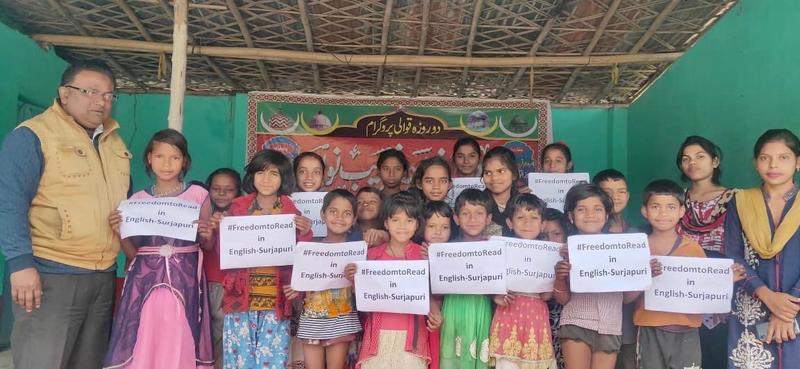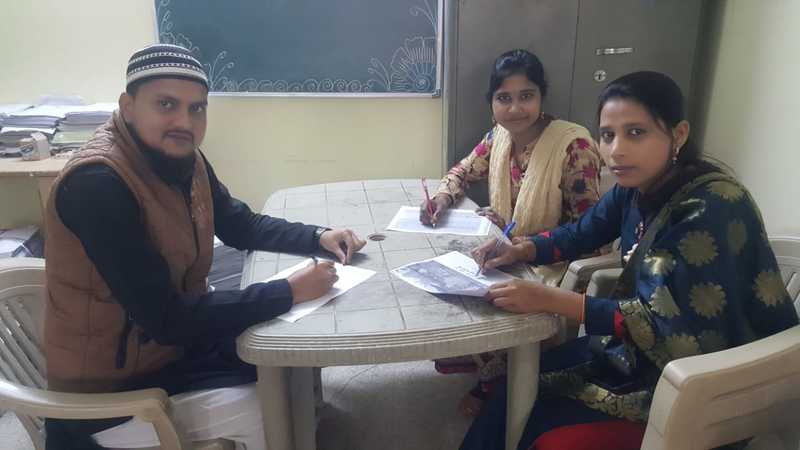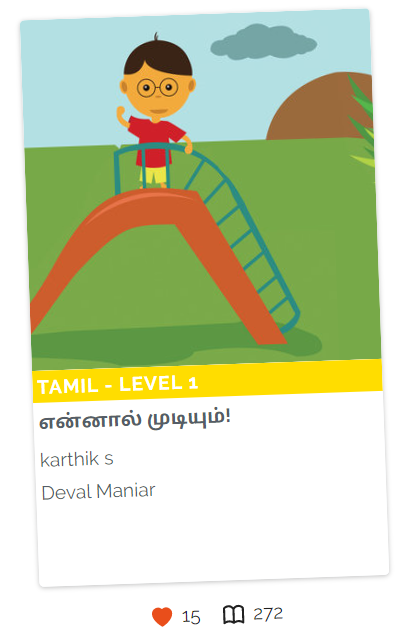One Day, One Story...Many Languages!
Posted by Amna Singh on September 05, 2018Pratham Books' One Day, One Story is back with story reading sessions for children across India! On September 8, Pratham Books Champions all over India will use one book to conduct reading sessions for children in their communities. All sessions are conducted free of cost, and focus on children from under-served communities. You can read more about this event here.
This year, Season 7 of One Day, One Story will feature A Cloud of Trash, written by Karanjeet Kaur, and illustrated by Bhavana Vyas Vipparthi. It’s a story about a little girl called Cheekoo, who has a cloud of trash hanging over her head. This makes her very, very unhappy, and as we follow her story, we learn a little more about trash, and about keeping our surroundings clean.
Last year, 5700+ Champions took the story of Kottavi Raja and his Sleepy Kingdom to thousands of children – conducting 6300+ storytelling sessions in 26 languages, in 25 states and 3 union territories in India. As well as 13 other countries.
We need your help to help children discover the joy of stories, and fall in love with reading. The more languages a story is translated in, the more it will travel to be read and enjoyed by children.
A Cloud of Trash, a reading level 2 story, is already available in English, Hindi, Kannada, Tamil, Gujarati, Konkani, Marathi, Bengali, Odia, Sanskrit, Punjabi, Telugu, Maithili and also, in Surjapuri and International languages like Portuguese, Basa Sunda, French, Spanish, Bahasa Indonesia, Czech, Italian, Norwegian,and Chinese too. Join in as a Translation Volunteer to translate this story to a new language. Your contribution to add a language version of this story on StoryWeaver will go a long way in multiplying the number of PB Champs' reading sessions and in turn, help reach more and more kids. We have also created a level 1 version of this story for sessions with a younger audience. You can weave a translation of this version too if you like.
Wouldn’t that be lovely?
We need all the translations to be on the site before 30th August.
If you have any queries please write to us at [email protected]
Here's a quick and easy video tutorial on how to translate stories on StoryWeaver. Once you've seen it, you can head over to the site to start translating A Cloud of Trash.
P.s: If you're interested in joining us as a PB Champ this year, click here to enrol.
Be the first to comment.
#FreedomtoRead2020: Azad India Foundation on creating 70+ Surjapuri bilingual books
Posted by Remya Padmadas on February 21, 2020
Azad India Foundation (AIF) was founded by Yuman Hussain in 1998 to seed initiatives in education & primary health care. The organisation's activities reach out to marginalised women, adolescents and underserved children from rural and urban areas of the Kishanganj district in Bihar.
We are delighted that AIF is participating in our Freedom to Read campaign for the second year in a row. They are also our first partner-translator this year to have completed their goal of translating 70+ Surjapuri bilingual books (English-Surjapuri and Hindi-Surjapuri). In an email interview, Yuman Hussain, Executive Director of Azad India Foundation, tells us about the importance of bilingual books and how these books have helped children read and learn in their mother tongue.

The Azad India Foundation team and the children in their learning centre in Bihar
“Azad India Foundation is delighted to be part of the #FreedomToRead campaign for the second year in a row. Foundational learning skills like reading are essential for a child’s progress. StoryWeaver is a unique platform that allows children to learn these skills joyfully in their mother tongue.”
- Yuman Hussain, Executive Director, Azad India Foundation
We are delighted that Azad India Foundation has participated in the Freedom to Read campaign for the second year in a row! How does it feel to be a part of the campaign for the second time?
It feels great to be part of the Freedom to Read campaign once again and to complete the translations well before time! The credit goes to the team. It was quite challenging this year as we chose to create bilingual books in English-Surjapuri.
Do tell us about the Surjapuri community and language: What is the mother tongue footprint and what resources are currently available? What are the challenges faced by Surjapuri children when they enter school?
Surjapuri is a dialect that is spoken in the Seemanchal area comprising Kishanganj, Araria, Katihar and Purnia of Bihar, and with minor variations in some parts of Bengal, neighboring Kishanganj.
I am currently not aware of any resources that are available for children in the local dialect of Surjapuri. In most schools, children learn in Hindi. In some schools, they are also taught in Urdu.
Can you tell us a little bit about how the Surjapuri books created from last year’s campaign are being used? Do the children have any favorites?
We have taken printouts of the Surjapuri books from last year’s Freedom to Read campaign and these are being used in classrooms for supplemental reading. Some of the STEM books are being used to explain maths and science concepts. The kids really like Gappu Can’t Dance (Gappu nachwa ne sakche) and enjoy enacting it in class. However, Fat King Thin Dog (Moto Raja Patla Kutta) is their all-time favourite!
This year, you’ve chosen to create bilingual books in English-Surjapuri and Hindi-Surjapuri. Could you tell us about the need and benefits of these books?
Bilingual books help children understand concepts easily, and if created in the local dialect, then it becomes so much easier for children to learn. The English-Surjapuri books are great teacher learning material (TLM) for non-Hindi or English speakers. Through StoryWeaver, we have access to thousands of free storybooks. We are aiming to create at least 200 books in Surjapuri on the platform.
We do not have reading material/storybooks in English for our children, so these bilingual books for level 1 and 2 are helping our children learn and read English. Aakansha, our India Fellow at AIF, helps with the reading sessions in English–Surjapuri.
Do tell us about your team who worked to create these 70+ Surjapuri bilingual books, and how they went about the translation process.
We have an enthusiastic young team of translators: Chand Quasar, Juhi and Saqlain, supervised by Muzzamil, who rose to the challenge once again. First, they translated storybooks from Hindi to Surjapuri. Then, I added the English version and uploaded the books on StoryWeaver. It was slightly challenging finding the corresponding words/sentences in English that matched the Surjapuri version, but it was fun.

Azad India Foundation's Team Badhte Kadam
Thank you so much, Azad India Foundation, for giving children the #FreedomToRead in Surjapuri!
You can read all the storybooks translated by Azad India Foundation here.
Read more about the organisation here.
Do join the conversation by leaving your thoughts in the comments section below. You can also reach out to us through our social media channels: Facebook, Twitter and Instagram.
Be the first to comment.On translating children's books: A Google Serve volunteer's story
Posted by Remya Padmadas on January 06, 2020Karthigeyan Sivaraj is a Google Serve campaign volunteer who has worked with StoryWeaver to help translate several storybooks into Tamil, including I Can Climb! and My Best Friend.
In this Q&A, Karthigeyan shares his experience about translating on StoryWeaver, his insight into the translation process, and his love for children's literature.

Q: Do tell us a little bit about yourself, your interests, your work
I'm a Googler by profession and by practice, and I'm proud of that! At work, being a Googler means respecting my colleagues and welcoming their opinions and ideas, howsoever different they may be to my own, and keeping things necessarily simple to my stakeholders, and I attempt to do the same outside the walls of my office as well. Having learned how to analyze data on the job, I brand myself as a data story-teller - i.e., processing data and presenting meaningful information in a way that pushes the audience to take the desired action. The interesting aspect of my job is that it allows me to improve the existing processes through imaginative ways and take ownership of some of the workflows in my organisation, thereby ensuring candidates joining Google have a lasting positive impression about their onboarding experience.
Q: Do you remember the first time you heard about StoryWeaver? What are your thoughts about the platform?
Of course, it's quite vivid in my memory the first time I heard about StoryWeaver. The concept of weaving children's stories is quite dear to my heart, and it's really gladdening to see the team working behind crafting stories as well as making them available in multiple different languages for the young audience to read and relish. I personally nurtured a similar idea a few years ago when I was an avid blogger but didn't have the imaginative power nor the enterprising capabilities to venture into this domain - I was really happy to find the StoryWeaver team doing some marvellous work in this field. Kudos to all!
Q: What was your experience of the GServe campaign, and translating books with fellow Google volunteers?
It's always a very humbling experience to take part in any GServe campaign, no matter what the cause that's being championed. The StoryWeaver campaign was very well thought through in many ways - for one, it didn't require us to sacrifice the luxury of our desks and we could contribute while at work or on the move. It was also so much fluid socializing with fellow Googlers who were taking up similar translation work. Overall, it was a rewarding experience to be able to contribute our might in little ways possible to make a huge change!
Q: We are so glad that you came on board as a commissioned translator even after the GServe campaign! What prompted you to stay in touch?
As I had mentioned previously, contributing to children's literature was always dear to me, and when I got to know about StoryWeaver's mission and their robust infrastructure, I felt relieved knowing that I didn't have to worry too much about the modus operandi, but rather focus on the work itself. With a major piece of work shouldered by the StoryWeaver team, I wanted to work with the team even after the GServe campaign, so that I could do what I like to do - writing, crafting and translating.
Q: What was your experience of being a commissioned translator? Did you pick up any new tips and techniques?
A lot I must say! One very important technique I adopted pretty early on was that I realized that translating the original work into the language of my preference required knowing the cultural nuances deeply. For instance, while translating a story from English targeting the Hindi speaking audience and translating it into Tamil would mean we will have to take into account the various cultural aspects such as the equivalent idioms used in the region. Internalizing all these cultural & regional nuances in the local language while translating is imperative if the audience has to relate to the stories. Else, they wouldn't 'stick'!
Q: How tricky is it to translate stories to Tamil? Are there any phrases that you particularly spent time on because they were difficult to translate?
Tamil, for all its richness, is a very unique language in that there are several different dialects in use across the Tamil diaspora. It becomes even trickier when you realize that the written form of the language is very different to the conversational style, and even the conversational style assumes a different shade when it comes to young audiences. Stories will have to be narrated to children in a style that's neither too formal nor too conversational and we should be ready to use a few English words that are in daily use, so they can relate to them. Also, unfortunately, tools such as Google Translate provide very literal translations of phrases which is sometimes very challenging even to the mature audience, hence you have to take a judgement call based on your own intuition and observation. I bet this is true for many Indic languages!
Q: What has been your favourite book to translate on StoryWeaver?
That's a tough one! Each of the books takes you down memory lane and makes you relive your childhood :) Be it Rani's First Day at School or the restless lad who couldn't wait to open this birthday gifts the next day or the fearless little girl - each provides a glimpse of your own childhood. For the sake of picking one, I would go for I Can Climb! which is packed with a lot of positive self-talk for young kids who are taking baby steps as they encounter different activities for the very first time in their lives.

Q: What are some of your favourite books from childhood? Is there any memorable reading moment that you would like to share?
I relished reading across different genres in both English and Tamil. In Tamil literature, especially that was taught to us in school, all messages were delivered in a cryptic fashion replete with metaphors and similes. That allowed for deep learning, situational paraphrasing and lateral thinking. For that very same reason, I preferred the works of John Milton, Rudyard Kipling & John Keats in English and innumerable poets in Tamil.
As a kid, I was an avid read of Tinkle Kids' magazines, and I used to eagerly await the next monthly edition. I am really glad to see that same level of curiosity now possessed by my niece. It seems the magazine hasn't lost its attractiveness to date!
Q: The translations you have contributed to our platform have been read over 1800 times - thank you! How has your StoryWeaver journey been? What is one big takeaway from this experience?
The biggest takeaway for me has been that we shouldn't shy away from walking in the little shoes of our young audience to truly understand what holds their curiosity and interest. Many a time, we - adult learners - tend to wear our own caps, and view children's literature in a rather lop-sided manner. However, we should be ready to speak the language of the kids (sometimes even practise prattling), simplify the language (without over-simplifying at the cost of losing the essence) to suit them and be more imaginative (what helped me to feel the pulse of the audience was to subject my work to, what I like to call, the 'niece'-test - i.e., talking to my nieces and having them vet some of my initial works)
Do leave your thoughts in the comments section below. You can also reach out to us through our social media channels: Facebook, Twitter and Instagram.
Be the first to comment.